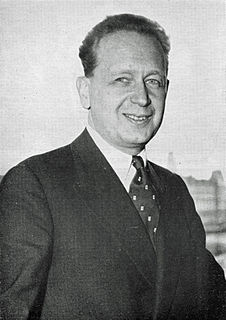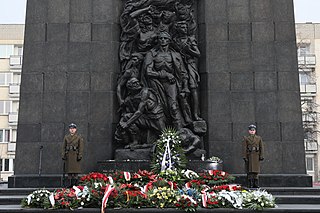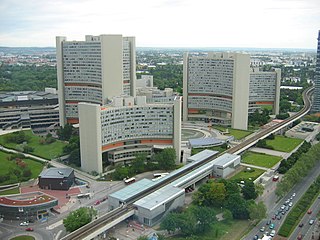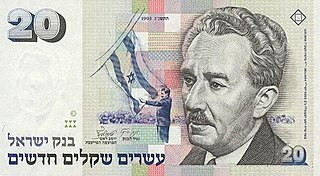Related Research Articles

Dag Hjalmar Agne Carl Hammarskjöld was a Swedish economist and diplomat who served as the second Secretary-General of the United Nations from April 1953 until his death in a plane crash in September 1961. As of 2022, he remains the youngest person to have held the post, having been only 47 years old when he was appointed.

The United Nations Secretariat Building is a 505-foot (154 m) tall skyscraper and the centerpiece of the headquarters of the United Nations, in the Turtle Bay/East Midtown neighborhood of Manhattan in New York City, alongside the East River. Although it remains geopolitically located within the United States, the lot where the building stands is considered to be under United Nations jurisdiction. It is the first skyscraper in New York City to use a glass curtain wall.

The United Nations Operation in the Congo was a United Nations peacekeeping force deployed in the Republic of the Congo in 1960 in response to the Congo Crisis. ONUC was the UN's first peacekeeping mission with significant military capabilities, and remains one of the largest UN operations in both scale and operational scope.

The International Holocaust Remembrance Day, or the International Day in Memory of the Victims of the Holocaust, is an international memorial day on 27 January that commemorates the victims of the Holocaust, which resulted in the murder of one third of the Jewish people, along with countless members of other minorities between 1933 and 1945 by Nazi Germany, an attempt to implement their "final solution" to the Jewish question. 27 January was chosen to commemorate the date that Auschwitz concentration camp was liberated by the Red Army in 1945.

The Dag Hammarskjöld Library is a library on the grounds of the headquarters of the United Nations, located in the Turtle Bay/East Midtown neighborhood of Manhattan in New York City. It is connected to the Secretariat and Conference buildings through ground level and underground corridors. It is named after Dag Hammarskjöld, the second Secretary-General of the United Nations.
The UN Chronicle is the digital magazine of the United Nations that furnishes a forum for exchange between experts and politicians working outside the Organization and United Nations officials and diplomats.

The United Nations Office at Vienna (UNOV) is one of the four major office sites of the United Nations where numerous different UN agencies have a joint presence. The office complex is located in Vienna, the capital of Austria, and is part of the Vienna International Centre, a cluster of several major international organizations. UNOV was established on 1 January 1980, and was the third such complex to be created.

United Nations General Assembly Resolution 273 was adopted on May 11, 1949, to admit the State of Israel to membership in the United Nations. It was passed following the approval of UN Security Council Resolution 69 on March 4, 1949.

The Dag Hammarskjöld Foundation, is a non-profit foundation based in Uppsala, Sweden that aims to strengthen policy on international cooperation, development and peacebuilding through its various programs.
The United Nations issues most of its official documents in its six working languages: Arabic, Chinese, English, French, Russian and Spanish. Many are also issued in German, which in 1973 gained the status of "documentation language" and has its own translation unit at the UN. The official documents are published under the United Nations masthead and each is identified by a unique document code (symbol) for reference, indicating the organ to which it is linked and a sequential number. There are also sales publications with distinctive symbols representing subject categories, as well as press releases and other public information materials, only some of which appear in all the official languages.

Dr. Noeleen Heyzer is a Singaporean social scientist who was Under-Secretary-General of the United Nations and Executive Secretary of the United Nations Economic and Social Commission for Asia and the Pacific (ESCAP). She was the first woman to hold the latter position since ESCAP's founding in 1947. She is currently Lee Kong Chian Distinguished Fellow at the SMU School of Social Sciences. She was also the United Nations Secretary-General's Special Adviser for Timor-Leste, working to support peace-building, state-building, and sustainable development. In 2005, she was nominated for the Nobel Peace Prize in recognition of her struggle to improve the lives of women, while always promoting peace and justice.
The Universal Declaration of Human Rights was drafted between early 1947 and late 1948 by a committee formed by the United Nations Commission on Human Rights. Further discussion and amendments were made by the Commission on Human Rights, the Economic and Social Council and the General Assembly of the United Nations.
The Dag Hammarskjöld Medal is a posthumous award given by the United Nations (UN) to military personnel, police, or civilians who lose their lives while serving in a United Nations peacekeeping operation. The medal is named after Dag Hammarskjöld, the second Secretary-General of the United Nations, who died in a plane crash in what is now Zambia in September 1961.

United Nations Security Council resolution 1121, adopted unanimously on 22 July 1997, after recalling that the maintenance of international peace and security was one of the main purposes of the United Nations, the council established the Dag Hammarskjöld Medal, named after the second Secretary-General Dag Hammarskjöld, awarded posthumously to United Nations peacekeepers.

United Nations Security Council resolution 1342, adopted unanimously on 27 February 2001, after recalling all previous resolutions on Western Sahara, in particular resolutions 1108 (1997), 1292 (2000), 1301 (2000), 1309 (2000) and 1324 (2000), the Council extended the mandate of the United Nations Mission for the Referendum in Western Sahara (MINURSO) until 30 April 2001.
United Nations General Assembly Resolution 34/37, titled Question of Western Sahara, is a resolution of the United Nations General Assembly about the situation in Western Sahara, which was adopted on 21 November 1979 at the 34th session of the General Assembly. It became the eighteenth United Nations General Assembly document concerning the situation of that territory.

On 18 September 1961, a DC-6 passenger aircraft of Transair Sweden, operating for the United Nations, crashed near Ndola, Northern Rhodesia. The crash resulted in the deaths of all people onboard including Dag Hammarskjöld, the second Secretary-General of the United Nations, and 15 others. Hammarskjöld had been en route to cease-fire negotiations with Moise Tshombe during the Congo Crisis. Three official inquiries failed to determine conclusively the cause of the crash, which set off a succession crisis at the United Nations.
United Nations General Assembly Resolution 40/50, entitled Question of Western Sahara, is a resolution of the United Nations General Assembly about the situation in Western Sahara, which was adopted on 2 December 1985 at the 40th session of the General Assembly.

The Seventy-third session of the United Nations General Assembly was opened on 18 September 2018. The President of the United Nations General Assembly was from the GRULAC group.

The League of Nations archives is a collection of the historical records and official documents of the League of Nations. The collection is housed at the United Nations Office at Geneva (UNOG), where it is managed by the Institutional Memory Section (IMS) of the UN Library & Archives Geneva. It consists of approximately 15 million pages of content and comprises nearly 3 linear kilometers. The League of Nations archives' historical significance is recognized by UNESCO, with its inscription on the Memory of the World Register in 2009.
References
- ↑ "United Nations Digital Library". Indiana University Libraries. 2002-01-28. Retrieved 2022-02-10.
- ↑ "Welcome to Permanent Mission of India to the UN , New York". Welcome to Permanent Mission of India to the UN , New York. 2015-07-15. Retrieved 2022-02-10.
- ↑ Nations, United. "The United Nations Digital Library is here!". United Nations. Retrieved 2022-02-10.
- ↑ "Research Guides: United Nations Digital Library: About". Research Guides at United Nations Dag Hammarskjöld Library. 2017-05-17. Retrieved 2022-02-10.
- ↑ Nations, United. "1 Million Records in the UN Digital Library". United Nations. Retrieved 2022-02-10.